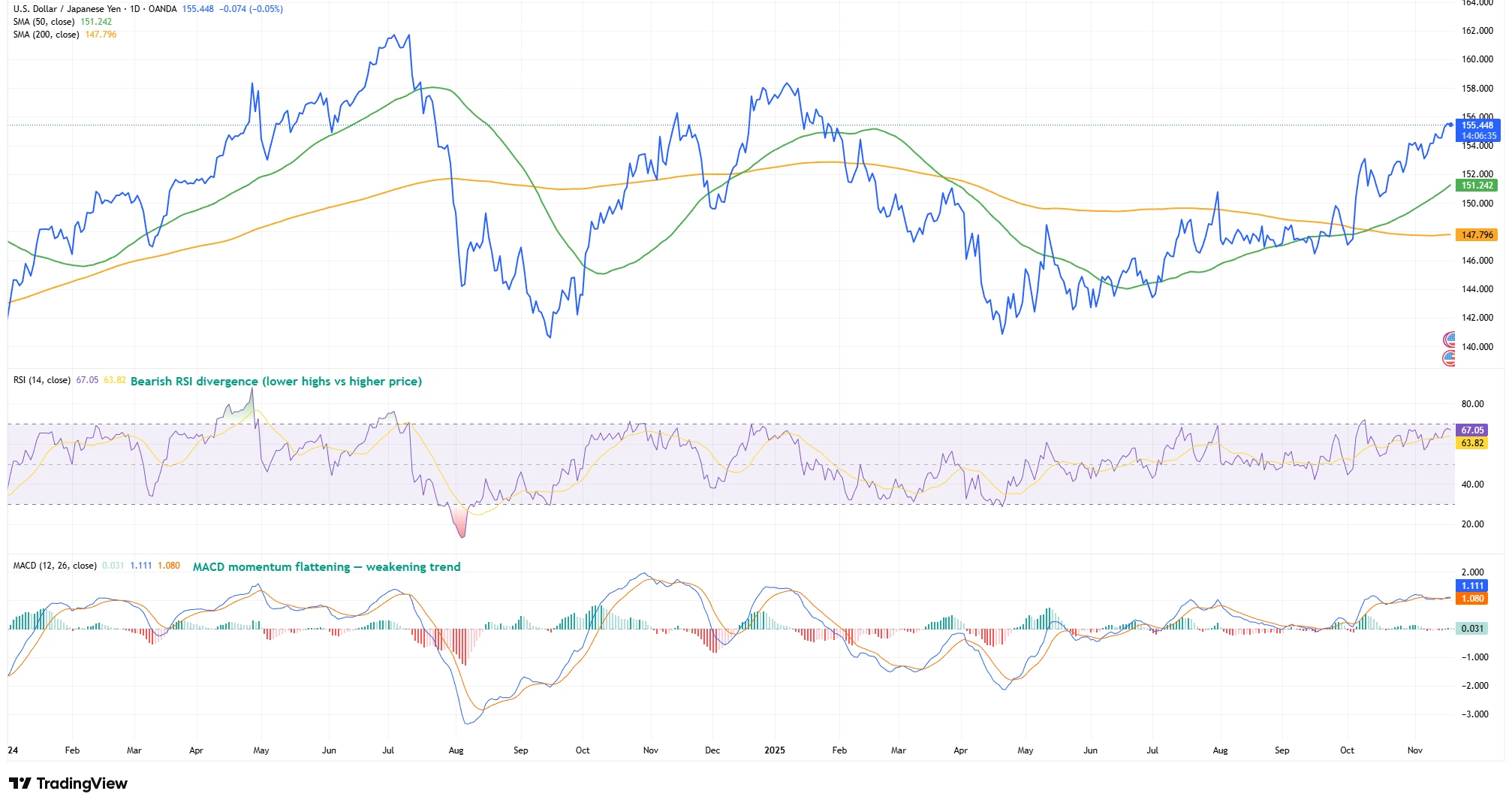Is the Yen Finally Catching Its Breath? Cracks in USD/JPY’s Parabolic Run
For two years, the dollar’s climb against the yen has been one of the biggest stories in FX, powered by a yawning interest-rate gap between the US and Japan. That gap made shorting the yen almost a no-brainer. But now, things feel… different. The pair is pressing against multi-decade highs, volatility is ticking up, and Tokyo is sounding more urgent. It’s the kind of moment where traders pause and ask: Is this the top?
The Chart Is Starting to Look Tired
USD/JPY has been on a rocket ride, but the slope is flattening. Daily charts still show higher highs, yet momentum is fading. RSI has been stuck in overbought territory and even slipping lower while prices push up (a classic bearish divergence!). MACD bars are shrinking (as seen in the chart below), and those long upper wicks on recent candles? They scream hesitation. In short: the parabolic curve is bending. Late buyers are climbing a steeper hill with less oxygen.
USD/JPY Retests Long-Term Resistance as Momentum Weakens

Source: TradingView. All indices are total return in US dollars. Past performance is not a reliable indicator of future performance. Data as of 19 November 2025.
The pair is retesting a long-term descending trendline while RSI and MACD show early bearish divergence, early signs that the parabolic uptrend may be losing steam.
On the weekly chart, the broader uptrend is still visible, but each push higher is losing strength. Momentum is flattening, and the price structure is no longer accelerating the way it did earlier in the cycle (at least like in 2024). Each new high is coming with less conviction than the last.
Intervention Risk & Macro Undercurrent
Beyond the charts, the bigger story is shifting. Tokyo’s Ministry of Finance and the BoJ have turned up the volume on their warnings. The dollar recently pushed past 155 yen – a level that brings back memories of past interventions. That surge has put traders on alert. Finance Minister Katayama has already flagged “rapid, one-sided moves” as unacceptable, stressing a “high sense of urgency.” That means if yen weakness gets too extreme, Tokyo might step in. And here’s the catch, USD/JPY is sitting in the same 155-160 zone where Japan has acted before. That’s why every spike now feels like it could trigger a response.
On the macro side, the narrative that powered this rally may be losing steam. The yen’s slide was built on a massive rate gap: US yields high, Japan near zero rates. If that gap narrows, say, because US yields dip on softer inflation or the BoJ tightens more aggressively, the carry trade starts to look less attractive. If markets begin pricing in fewer Fed cuts or more BoJ hikes, the tailwind that drove USD/JPY higher could turn into a headwind fast.
Carry Trade Unwind: The Risk Nobody Wants to Talk About
The USD/JPY carry trade has been a monster. Borrow cheap yen, buy higher-yielding US assets, simple, profitable, and crowded. But that math only works if US yields keep rising and Japan stays quiet. If USD/JPY stalls here, the logic starts to break down. And when crowded trades lose momentum, exits aren’t orderly, they’re brutal!
A clean break below short-term support could trigger exactly that. We’ve seen how fast complacency turns into panic when these trades unwind. Technical strategists warn that if support gives way, it could ‘open the door’ for a sharp move lower… maybe even a retest of the October 2023 lows. That’s a long way down from here.
What to Watch: Key Signals on the Horizon
If you’re tracking USD/JPY, here are the pressure points that matter:
• Trendline Rejection: If USD/JPY fails to break above the long-term descending trendline (around 155-156), it signals exhaustion.
• Momentum Flip: RSI dropping back below 60 or breaking below 50 confirms weakening bullish control.
• Breakdown Levels: A move below 153.00 (nearest swing support) would be the first confirmation. Below 150 = trend fully compromised.
• Intervention Risk Signals: Sharp single-day yen spikes (1–2%) often occur near major resistance zones like this.
Closing Reflection
The yen has been quiet for a long time, but markets rarely stay calm forever. Charts often whisper before fundamentals shout, and right now, that whisper is getting harder to ignore. Whether this marks the start of a deeper reversal or just a breather at the top, one thing is clear: USD/JPY’s parabolic arc isn’t as flawless as it once seemed. For traders, that means staying alert, because when a trend this crowded starts to bend, it rarely bends back.